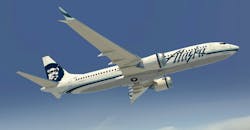The U.S. Federal Aviation Administration issued a temporary grounding order for a number of Boeing 737 MAX 9 aircraft operated by U.S. airlines or in U.S. territory. The Saturday, January 6 Emergency Airworthiness Directive came several hours after an Alaska Airlines flight from Portland, Ore., to Ontario, Calif., experienced an in-flight emergency shortly after takeoff when a side panel in the cabin was blown open, depressurizing the aircraft.
The jet returned to Portland and landed safely with all 171 passengers and six crew members.
737 MAX fuselage structures are manufactured by Spirit AeroSystems with an optional side-door panel, which may be needed for high-capacity seating arrangements. That door is frequently not required by airline customers, and while the opening may be used by Boeing when outfitting the cabin during assembly a structural segment is installed and sealed for the completed airframe.
It was the fill-in structure that failed and was blown open on the Alaska Airlines jet.
The damaged aircraft was nearly new, having been delivered and put into service in October 2023.
The FAA’s directive requires operators of a total of 171 aircraft to inspect the jets before they can be returned to service. The agency noted the required inspections will take around four to eight hours per aircraft.
Boeing’s other currently available 737 MAX model, the shorter MAX 8, is not affected by the FAA order.
Alaska Airlines operates an all-737 fleet, with 65 737 MAX 9s in service now and 15 more due to be delivered. The carrier is among Boeing’s largest customers, with orders in place for more than 130 737 MAX 8, 9, and 10 jets due to be delivered.
The 737 MAX is Boeing’s top-selling model, with more than 1,300 of the aircraft in service and about 4,500 more on order or awaiting delivery. However, the OEM has struggled to expand the monthly production rate for the jets due to a series of problems in its manufacturing supply chain over recent months.
"Safety is our top priority and we deeply regret the impact this event has had on our customers and their passengers,” according to a Boeing statement on January 6. “We agree with and fully support the FAA's decision to require immediate inspections of 737-9 airplanes with the same configuration as the affected airplane. In addition, a Boeing technical team is supporting the NTSB's (National Transportation Safety Board) investigation into last night's event. We will remain in close contact with our regulator and customers."
The incident is apparently unrelated to a maintenance directive that Boeing issued to 737 MAX operators in late December, involving a possible defect in the rudder control system. That detail was discovered in a non-U.S. carrier’s jet and reported by the FAA. Boeing also found such a defect on an undelivered 737 MAX jet.
The incident also bears no similarity to the two fatal accidents that grounded the 737 MAX for 20 months, from March 2019 to December 2020. That problem involved the automated flight-control system. Once the system was revised and the aircraft were updated, the FAA and other safety regulators restored the 737 MAX’s airworthiness certification.
About the Author
Robert Brooks
Content Director
Robert Brooks has been a business-to-business reporter, writer, editor, and columnist for more than 20 years, specializing in the primary metal and basic manufacturing industries.
